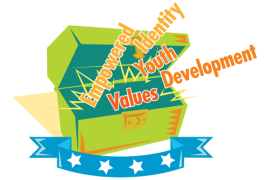“Not everything that is faced can be changed, but nothing can be changed until it is faced.” –James Baldwin
Here’s the truth: we were all raised differently — even those of us who share similar visible and invisible identities. No matter how lightly we try to tread or how much we pretend our differences don’t exist, disagreements are bound to happen.
Talking about this in camp communities sometimes seems wrong, because we all tend to view camp as our happy place and a time to shower each other with positivity. I still remember showing up summer after summer as a seasonal staff member excited for all the new possibilities, ready to work in a community filled with love. Sometimes I’d forget that camp exists in the real world, no matter how far removed we may feel from it some days. Now I know that learning how to live in diverse communities is more than just a great skill to have; it also helps us to engage in new learning and to experience the beauty of growth through true inclusion.
What Defines an Intentionally Inclusive and Diverse Community?
Such communities offer a clear purpose for each member. Their leadership communicates this fact and does not force assimilation into a majority’s group culture (Howard James, 2018). What this actually looks like in practice may be different for each camp, but before your season officially starts, it is important that you understand your camp’s vision of inclusion and embracing diversity. And that you support this vision and actively work to help it succeed. If your personal values do not align with your camp’s vision, you could unintentionally sabotage inclusion advancement of the whole community — and now, before camp begins, might be a good time to voice any misalignment concerns to your leadership.
When inclusion is not an intentional act, a hidden culture of exclusion can grow — one in which only some will feel they belong. An exclusionary culture may show itself in many ways, but one common example occurs when returning staff resist changes to the way things are done. If that is you, your experiences and happiness with past systems are valid, but they may be the reason why new staff do not feel included. Intentionally inclusive communities embrace the different experiences, views, and cultures of all who are present. However, expressing hateful or intolerant opinions toward individuals/groups at camp is never OK.
Intentionally inclusive and diverse communities leave room for a changing demographic that allows identity expression to happen on a spectrum. You can accomplish this by being open-minded to the way others dress, what music is played, how games are facilitated, what food is served during meals, and so on.
Why Is It Important That Our Communities Be Intentionally Inclusive and Diverse?
University of Richmond honors thesis writer Ingrid Hale said, “Common sense has always told us that living and learning in a diverse environment — where individuals have deep exposure to people different from themselves — makes one more compassionate and better equipped to make a difference in the world” (Hale, 2021).
As staff who work with youth and young adults, it is important to see the value in exposing campers and ourselves to others who share identities, experiences, and culture unlike our own. All people benefit from living and working in places that have visible and nonvisible diversity in its members. Compassion and empathy are formed through removing the veil of ignorance to others’ lived experiences. Only through true and intentional inclusion can we make spaces for those who hold historically marginalized identities to share their genuine selves. With this mindset we can make a greater impact in our campers’ lives and be a community that seeks to understand each other as individuals — beyond our labels.
What Does This Look Like among Colleagues?
Naturally, when people are in uncomfortable situations like entering new communities we seek ease. Even if you spent multiple summers as a camper or have worked previous summers, you can experience looking for comfort upon arriving at camp. This comfort usually comes from connecting with someone or a group who brings us familiarity; it reminds us of groups we have been a part of before. This is why and how people in similar identity groups automatically connect at the start of staff training.
Common identity groups at camp through which people naturally connect:
- New staff or returning staff
- Cabin leaders
- Race/ethnicity
- Gender
- College or university attending/attended
Now there is value in having affinity groups (individuals who share identities), because it provides those involved with reassurance and validation of their experiences (Pendharkar, 2022). The goal is to find a balance where we see value in all spaces happening in our camp communities.
Tips for Staff Making New Connections across Differences
Rip the Band-Aid off. This can be awkward at first but will get easier once you have started the conversation. Sit at a new table. Find a person you already feel comfortable with and ask them to introduce you to a different group, and use already planned icebreaker games to your benefit. You’re at camp, so silly questions or riddles are great!
Lead with soft curiosity. It can be exciting to meet a person who is from a different culture or place, or whose identities are unlike your own. Remember that some topics may be sensitive or personal, so engage in asking questions as they naturally present themselves. Don’t push a conversation in a direction that it is not naturally flowing, an action an individual could perceive as invasive and ruin a new connection.
Monitor your body language and tone. Use your body language during conversations to show that you respect the person’s space and to communicate your openness to the conversation. Watch how you make statements to ensure you don’t convey a condescending undertone — which can happen when we assume a person’s knowledge or lack thereof.
Drop the camp jargon. Don’t assume that a person has been exposed to the same things as you were growing up. Many phrases, such as “leave no trace,” aren’t as common as you may think. Don’t be afraid to drop acronyms or follow up with explanations if a person’s face shows confusion.
Respect boundaries. Learning can happen in many ways, including through interpersonal connections. It also can be emotionally taxing to be the main source of education to folks outside of your identities and culture. So respect when a person turns down opportunities to educate you or redirects you to other sources of information.
Poet and activist Maya Angelou said, “Do the best you can until you know better. Then when you know better, do better.” Try not to feel shame for not knowing these tips already. It takes first being made aware of patterns to intentionally diversify your friend groups. If you aren’t super outgoing, taking the first steps to engage in making new connections may be even more challenging. Give yourself grace as you continue to learn and challenge yourself to enter your growth zone. Growth zone is different from being in your danger zone, which feels unsafe rather than just uncomfortable (Sam, 2020).
How Can This Be Translated to Work with Campers?
Just like your fellow staff, campers come from all different locations, backgrounds, and cultures. While you could easily assume a camper’s life based on their camper bio or a conversation with their parents at drop off, it’s important to view meeting diverse youth with the same intentionality as working with your staff peers. Be aware of your own biases — implicit or explicit — so you can work to unlearn harmful thoughts that can lead to harmful actions.
Do You Know Your Biases?
Implicit bias: “a bias or prejudice that is present but not consciously held or recognized” (Merriam-Webster, 2023).
Explicit bias: “refers to the attitudes and beliefs we have about a person or group on a conscious level . . . Expressions of explicit of bias (discrimination, hate speech, etc.) occur as the result of deliberate thought” (Perception Institute, n.d.).
Campers may also struggle to interact with those who seem different than them within the camp environment. This is where staff can step in to help make those connections across differences and model intentional inclusion of others. When harm is done whether intentionally or unintentionally, we should work to first create space for honesty, clearly address the harmful behavior, and make the situation a learning experience for all involved.
Steps to remember if you cause unintentional harm:
- Take immediate ownership of the action. If someone names something you have said or done that has harmed them, immediately take accountability regardless of your intent. For the conversation to progress, you must validate the hurt person’s experience.
- Actively listen and ask questions. Listen to them describe the hurt and ask questions if you are unsure why something you did/said was wrong. Remember to monitor your own body language and tone of voice so you relay curiosity and not defensiveness.
- Communicate your intent. After you have taken accountability and completely understand the problem, describe your intent. This is also a good time to genuinely apologize for your actions.
- Ask what they need. Give the harmed person the opportunity to express what they need to happen for you both to move forward. Note that they may not know immediately and may need time to think before they respond. Don’t rush this process; it is an important step in healing from the situation.
- Reflect. Both parties should take time after the conversation to reflect on what led to harm, how the conversation went, and what emotions are present now.
Final Thoughts
We will bump heads in between the good times at camp — because we are real people. And we will face these moments with awareness. By no means is this a simple task, and knowing what to say in the moment takes practice. In community we all have the responsibility to help intentionally build a culture where everyone is included. We should give ourselves and those around us grace if real effort is being made to learn how to live purposefully in inclusive and diverse communities. Embracing our differences may be a change for some of us — but nothing can change until we take the first steps to facing it.
Other Helpful Resources
- Luvvie Ajayi Jones’s TED Talk, Get Comfortable with Being Uncomfortable: youtube.com/watch?v=QijH4UAqGD8&t=1s
- The American Association of University Women’s diversity, equity, and inclusion tool kit, Getting Started with Difficult Conversations: aauw.org/resources/member/governance-tools/dei-toolkit/difficult-conversations
- HSBC’s Cultivating a Culture of Inclusion: youtube.com/watch?v=oSO3F9z23vU
Discussion Questions
- Have you ever been new to a community and tried to make connections? What feelings do you remember having? What helped you begin to come out of your shell?
- What are some barriers that may be present when trying to make connections with people in different identity groups?
- What are some encouraging things to say as a staff member to campers who may be afraid to interact with other campers who seem different from them?
- How can camp staff hold each other accountable to intentionally include each other and campers throughout the summer?
Ambrean Ford, LLMSW, is the director of community life, diversity, and inclusion at the American Youth Foundation.
References
- Hale, I. (2021, April 30). Understanding the effectiveness of diversity, equity, and inclusion initiatives at youth summer camps. Honors Thesis, University of Richmond. scholarship.richmond.edu/cgi/viewcontent.cgi?article=1013&context=spcs-nonprofitstudies-capstones
- Howard James, B. (2018, May 16). Community, inclusion, and the individual. TEDx Deerfield. youtube.com/watch?v=XnhRsKoZSpI&t=13s
- Pendharkar, A. (2022, November 2). Safe space or segregation? Affinity groups for teachers, students of color. Education Week. edweek.org/leadership/safe-space-or-segregation-affinity-groups-for-teachers-students-of-color/2022/11
- Sam. (2020, February 20). The discomfort zone and what it means for your health and happiness. Harder and Smarter. smarterandharder.com/discomfort-zone/



